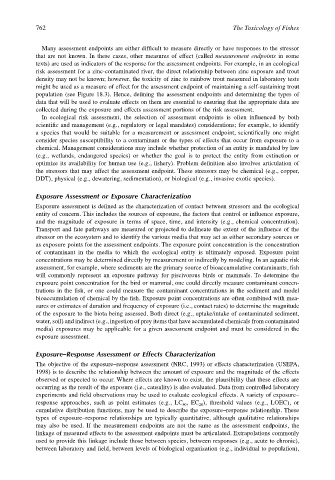Page 782 - The Toxicology of Fishes
P. 782
762 The Toxicology of Fishes
Many assessment endpoints are either difficult to measure directly or have responses to the stressor
that are not known. In these cases, other measures of effect (called measurement endpoints in some
texts) are used as indicators of the response for the assessment endpoints. For example, in an ecological
risk assessment for a zinc-contaminated river, the direct relationship between zinc exposure and trout
density may not be known; however, the toxicity of zinc to rainbow trout measured in laboratory tests
might be used as a measure of effect for the assessment endpoint of maintaining a self-sustaining trout
population (see Figure 18.3). Hence, defining the assessment endpoints and determining the types of
data that will be used to evaluate effects on them are essential to ensuring that the appropriate data are
collected during the exposure and effects assessment portions of the risk assessment.
In ecological risk assessment, the selection of assessment endpoints is often influenced by both
scientific and management (e.g., regulatory or legal mandates) considerations; for example, to identify
a species that would be suitable for a measurement or assessment endpoint, scientifically one might
consider species susceptibility to a contaminant or the types of effects that occur from exposure to a
chemical. Management considerations may include whether protection of an entity is mandated by law
(e.g., wetlands, endangered species) or whether the goal is to protect the entity from extinction or
optimize its availability for human use (e.g., fishery). Problem definition also involves articulation of
the stressors that may affect the assessment endpoint. These stressors may be chemical (e.g., copper,
DDT), physical (e.g., dewatering, sedimentation), or biological (e.g., invasive exotic species).
Exposure Assessment or Exposure Characterization
Exposure assessment is defined as the characterization of contact between stressors and the ecological
entity of concern. This includes the sources of exposure, the factors that control or influence exposure,
and the magnitude of exposure in terms of space, time, and intensity (e.g., chemical concentration).
Transport and fate pathways are measured or projected to delineate the extent of the influence of the
stressor on the ecosystem and to identify the various media that may act as either secondary sources or
as exposure points for the assessment endpoints. The exposure point concentration is the concentration
of contaminant in the media to which the ecological entity is ultimately exposed. Exposure point
concentrations may be determined directly by measurement or indirectly by modeling. In an aquatic risk
assessment, for example, where sediments are the primary source of bioaccumulative contaminants, fish
will commonly represent an exposure pathway for piscivorous birds or mammals. To determine the
exposure point concentration for the bird or mammal, one could directly measure contaminant concen-
trations in the fish, or one could measure the contaminant concentrations in the sediment and model
bioaccumulation of chemical by the fish. Exposure point concentrations are often combined with mea-
sures or estimates of duration and frequency of exposure (i.e., contact rates) to determine the magnitude
of the exposure to the biota being assessed. Both direct (e.g., uptake/intake of contaminated sediment,
water, soil) and indirect (e.g., ingestion of prey items that have accumulated chemicals from contaminated
media) exposures may be applicable for a given assessment endpoint and must be considered in the
exposure assessment.
Exposure–Response Assessment or Effects Characterization
The objective of the exposure–response assessment (NRC, 1993) or effects characterization (USEPA,
1998) is to describe the relationship between the amount of exposure and the magnitude of the effects
observed or expected to occur. Where effects are known to exist, the plausibility that these effects are
occurring as the result of the exposure (i.e., causality) is also evaluated. Data from controlled laboratory
experiments and field observations may be used to evaluate ecological effects. A variety of exposure–
response approaches, such as point estimates (e.g., LC , EC ), threshold values (e.g., LOEC), or
20
50
cumulative distribution functions, may be used to describe the exposure–response relationship. These
types of exposure–response relationships are typically quantitative, although qualitative relationships
may also be used. If the measurement endpoints are not the same as the assessment endpoints, the
linkage of measured effects to the assessment endpoints must be articulated. Extrapolations commonly
used to provide this linkage include those between species, between responses (e.g., acute to chronic),
between laboratory and field, between levels of biological organization (e.g., individual to population),

